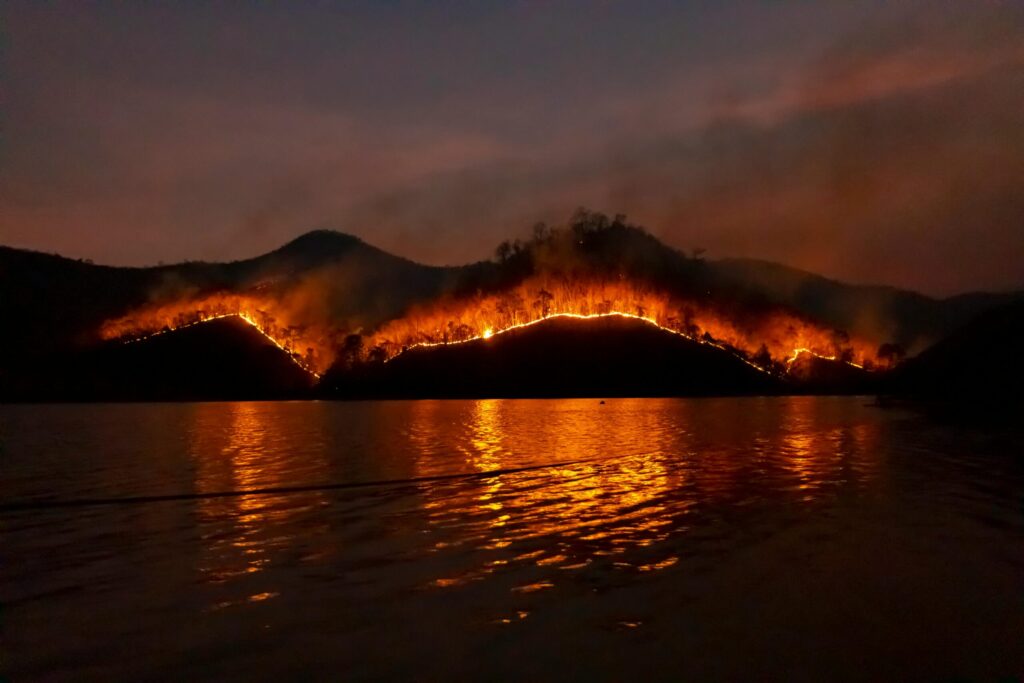Climate change is something that affects everyone. But some groups of people are especially affected by climate change. Many significant changes are causing harm around the world, such as:
These growing threats give way to new challenges that need to be addressed on a global scale.
I often worry about climate change and its consequences. I worry about the unknowns that it presents for my future, and the future of the world. The changing climate is creating new challenges, and our global structures need to respond. One prominent new challenge is the displacement of people as a result of climate disasters. People are being forced to leave their homes and often their countries as a result of climate disasters. This is creating a new group of displaced people – Climate Refugees.
 Wildfire on a mountain in Thailand
Wildfire on a mountain in Thailand
This is part one of a two part series, and it will address some of these newfound challenges of Climate Refugees, pose ideas, and steps that can be taken to help the situation.
Why ‘Climate Refugee’ vs Climate Displacement?
Climate change affects people in different ways, some more than others. In the United States I have seen the harm caused by natural disasters like the wildfires in California, the hurricanes in Florida, and the floods in North Carolina. These disasters are occurring more and more often, and affecting more and more people. The large size of the United States means that when people flee climate disasters, they are able to stay inside the country. This means they are displaced by climate change, but not ‘Climate Refugees’. Yet, around the world, climate disasters are forcing people to flee not only their homes but their countries. This is non-voluntary or forced displacement that is not temporary in nature.
Why is the term ‘Climate Refugee’ important?
The 1951 Refugee Convention defines refugees as people who flee conflict or persecution by going to another country. Article 1 of the 1951 Convention defines a refugee as someone who
owing to well-founded fear of being persecuted for reasons of race, religion, nationality, membership of a particular social group or political opinion, is outside the country of [their] nationality and is unable or, owing to such fear, is unwilling to avail [themself] of the protection of that country; or who, not having a nationality and being outside the country of [their] former habitual residence, is unable or, owing to such fear, is unwilling to return to it.
This definition arose due to the massive displacement of people following World War II. It was a way to classify and provide protections to people who fled their home countries because of violence or fear. This definition does not include people fleeing environmental disasters.
Yet, we are facing another crisis of massive displacement of people. Conflicts and climate change are interconnected in our world today. We need a new understanding of the current conditions forcing people to flee their homes. ‘Climate Refugees’ are forced to flee their homes and in the process, have crossed an international border. As a result, climate change and ‘Climate Refugees’ will impact global security, stability and international peace.
What is the connection between conflicts, climate and displacement?
The 1951 Refugee Convention is not currently effective for ‘Climate Refugees’. But the connection between conflicts, climate and displacement of populations are greatly increasing. Climate change may make it impossible for people to return to their country of origin. In fact, the civil wars in Sudan and Syria have both been influenced by climate change, as less rainfall has created more tension among neighboring groups. People fleeing conflict that was influenced by climate change are seen as refugees in the traditional sense of the word. The term Climate Refugees should not only include people fleeing wars influenced by climate change, but those non-voluntarily fleeing natural disasters too.
What role can Environmental Law play?
I propose that Environmental Law has the potential to help! Most cases in Environmental Law focus on the environment itself, instead of people. But there are cases in the past that helped the people affected by environmental damage. These take place all over the world, including:
- The Americas: An Advisory Opinion by the Inter-American court of Human Rights connects climate change to human rights in international law. This history connecting human rights and climate change paves the way to do the same thing with Climate Refugees.
- Côte D’ivoire: The court ruled that anyone who was exposed to dangerous waste was given financial reparations. This sets the stage for individual victims getting help after climate disasters, which could be applied to Climate Refugees too!
These cases set important persuasive, though not binding, precedent. Meaning, we could use their results for other situations, like advocating on behalf of ‘Climate Refugees’.
In part 2, I will explore how two principles – the Polluter Pays Principle, and Common but Differentiated Responsibility Principle – can help Climate Refugees. Climate Refugee is a term that is still in the making. Academics and we, as activists, have the opportunity to advocate for this term to include protections for a wider range of people forced to flee their communities. Stay tuned for Part 2 on Climate Refugees!
A Resource to Explore in the Meantime
Check out this website called ClimateRefugees.org! It raises awareness about Climate Refugees, tells individual stories, and tracks environmental disasters around the world. You can also find information about events on the website!